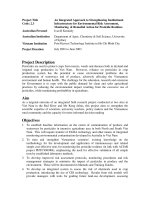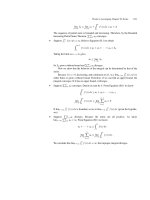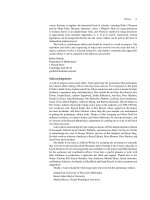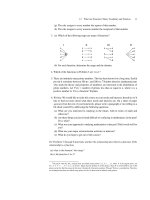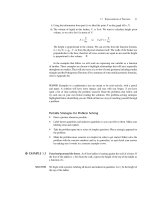Springer an integrated approach to software engineering 3rd ed p jalote (springer 2005) WW
Bạn đang xem bản rút gọn của tài liệu. Xem và tải ngay bản đầy đủ của tài liệu tại đây (32.68 MB, 571 trang )
TEXTS IN COMPUTER SCIENCE
Editors
David Gries
Fred B. Schneider
An Integrated Approach to
Software Engineering
Third Edition
Pankaj Jalote
Indian Institute of Technology Kanpur
Springer
Pankaj Jalote
Department of Computer Science
and Engineering
Indian Institute of Technology
Kanpur208016
India
Series Editors
David Gries
Fred B. Schneider
Department of Computer Science
Cornell University
Upson Hall
Ithaca, NY 14853-7501
Pankaj Jalote
Indian Institute of Technology Kanpur
Library of Congress Cataloging-in-Publication Data
A C.I.P. Catalogue record for this book is available
From the Library of Congress
ISBN-10: 0-387-20881-X(HB)ISBN-10: 0-387-28132-0 (eBook)
ISBN-13: 978-0387-20881-7 (HB)ISBN-13: 978-0387-28132-2 (eBook)
© 2005 by Springer Science-i-Business Media, Inc.
All rights reserved. This work may not be translated or copied in whole or in part without
the written permission of the publisher (Springer Science + Business Media, Inc., 233
Spring Street, New York, NY 10013, USA), except for brief excerpts in connection with
reviews or scholarly analysis. Use in connection with any form of information storage and
retrieval, electronic adaptation, computer software, or by similar or dissimilar
methodology now known or hereafter developed is forbidden.
The use in this publication of trade names, trademarks, service marks and similar terms,
even if they are not identified as such, is not to be taken as an expression of opinion as to
whether or not they are subject to proprietary rights.
Printed in the United States of America
987654321
springeronline.com
SPIN 10949597
Contents
Preface to the Third Edition
xiii
1
Introduction
1.1 The Problem Domain
1.1.1 Industrial Strength Software
1.1.2 Software is Expensive
1.1.3 Late and Unreliable
1.1.4 Maintenance and Rework
1.2 The Software Engineering Challenges
1.2.1 Scale
1.2.2 Quality and Productivity
1.2.3 Consistency and Repeatability
1.2.4 Change
1.3 The Software Engineering Approach
1.3.1 Phased Development Process
1.3.2 Managing the Process
1.4 Summary
Exercises
1
2
2
4
5
6
8
9
11
14
15
15
16
20
21
22
2
Software Processes
2.1 Software Process
2.1.1 Processes and Process Models
2.1.2 Component Software Processes
2.1.3 ETVX Approach for Process Specification
2.2 Desired Characteristics of Software Process
2.2.1 Predictability
2.2.2 Support Testability and Maintainability
2.2.3 Support Change
2.2.4 Early Defect Removal
25
25
26
27
29
31
31
33
34
35
vi
CONTENTS
2.2.5 Process Improvement and Feedback
Software Development Process Models
2.3.1 Waterfall Model
2.3.2 Prototyping
2.3.3 Iterative Development
2.3.4 Timeboxing Model
2.3.5 Comparision of Models
Other Software Processes
2.4.1 Project Management Process
2.4.2 The Inspection Process
2.4.3 Software Configuration Management Process
2.4.4 Requirements Change Management Process
2.4.5 Process Management Process
Summary
Exercises
36
37
37
41
43
46
50
50
52
54
61
67
69
73
75
Softw^are Requirements Analysis and Specification
3.1 Software Requirements
3.1.1 Need for SRS
3.1.2 Requirement Process
3.2 Problem Analysis
3.2.1 Informal Approach
3.2.2 Data Flow Modeling
3.2.3 Object-Oriented Modeling
3.2.4 Prototyping
3.3 Requirements Specification
3.3.1 Characteristics of an SRS
3.3.2 Components of an SRS
3.3.3 Specification Language
3.3.4 Structure of a Requirements Document
3.4 Functional Specification with Use Cases
3.4.1 Basics
3.4.2 Examples
3.4.3 Extensions
3.4.4 Developing Use Cases
3.5 Validation
3.6 Metrics
3.6.1 Size—Function Points
3.6.2 Quality Metrics
3.7 Summary
Exercises
79
80
81
85
89
90
91
103
113
117
118
120
124
125
128
129
132
135
136
138
142
142
147
148
150
2.3
2.4
2.5
3
CONTENTS
Case Studies
4
Software Architecture
4.1 Role of Software Architecture
4.2 Architecture Views
4.3 Component and Connector View
4.3.1 Components
4.3.2 Connectors
4.3.3 An Example
4.4 Architecture Styles for C&C View
4.4.1 Pipe and Filter
4.4.2 Shared-Data Style
4.4.3 Client-Server Style
4.4.4 Some Other Styles
4.5 Discussion
4.5.1 Architecture and Design
4.5.2 Preserving the Integrity of an Architecture
4.5.3 Deployment View and Performance Analysis
4.5.4 Documenting Architecture Design
4.6 Evaluating Architectures
4.6.1 The ATAM Analysis Method
4.6.2 An Example
4.7 Summary
Exercises
Case Studies
5 Planning a Software Project
5.1 Process Planning
5.2 Effort Estimation
5.2.1 Uncertainties in Effort Estimation
5.2.2 Building Effort Estimation Models
5.2.3 A Bottom-Up Estimation Approach
5.2.4 COCOMO Model
5.3 Project Scheduling and Staffing
5.3.1 Overall Scheduling
5.3.2 Detailed Scheduling
5.3.3 An Example
5.3.4 Team Structure
5.4 Software Configuration Management Plan
5.5 Quality Plan
5.5.1 Defect Injection and Removal Cycle
vii
152
159
160
163
167
167
169
172
176
176
178
181
182
183
183
184
188
190
194
195
196
199
201
203
207
208
208
209
211
213
215
219
219
221
223
224
225
226
227
viii
CONTENTS
5.6
5.7
5.8
6
5.5.2 Approaches to Quality Management
5.5.3 Quality Plan
Risk Management
5.6.1 Risk Management Concepts
5.6.2 Risk Assessment
5.6.3 Risk Control
5.6.4 A Practical Risk Management Approach
Project Monitoring Plan
5.7.1 Measurements
5.7.2 Project Monitoring and Tracking
Summary
Exercises
Case Studies
Function-Oriented Design
6.1 Design Principles
6.1.1 Problem Partitioning and Hierarchy
6.1.2 Abstraction
6.1.3 Modularity
6.1.4 Top-Down and Bottom-Up Strategies
6.2 Module-Level Concepts
6.2.1 Coupling
6.2.2 Cohesion
6.3 Design Notation and Specification
'
6.3.1 Structure Charts
6.3.2 Specification
6.4 Structured Design Methodology
6.4.1 Restate the Problem as a Data Flow Diagram
6.4.2 Identify the Most Abstract Input and Output Data
Elements
6.4.3 First-Level Factoring
6.4.4 Factoring the Input, Output, and Transform Branches
6.4.5 Design Heuristics
6.4.6 Transaction Analysis
6.4.7 Discussion
6.5 Verification
6.6 Metrics
6.6.1 Network Metrics
6.6.2 Stability Metrics
6.6.3 Information Flow Metrics
6.7 Summary
228
229
230
230
232
236
237
237
239
239
241
243
245
247
248
250
251
253
254
255
255
257
260
261
265
266
267
269
271
273
276
277
279
281
283
284
285
288
290
CONTENTS
Exercises
Case Studies
ix
292
294
7
Object-Oriented Design
7.1 GO Analysis and GO Design
7.2 GG Concepts
7.2.1 Classes and Objects
7.2.2 Relationships Among Objects
7.2.3 Inheritance and Polymorphism
7.3 Design Concepts
7.3.1 Coupling
7.3.2 Cohesion
7.3.3 The Open-Closed Principle
7.3.4 Some Design Guidehnes
7.4 Unified Modehng Language (UML)
7.4.1 Class Diagram
7.4.2 Sequence and Collaboration Diagrams
7.4.3 Other Diagrams and Capabilities
7.5 A Design Methodology
7.5.1 Dynamic Modehng
7.5.2 Functional Modeling
7.5.3 Defining Internal Classes and Operations
7.5.4 Optimize and Package
7.5.5 Examples
7.6 Metrics
7.7 Summary
Exercises
Case Studies
303
304
306
307
312
315
323
323
325
327
329
331
331
335
339
341
343
345
346
347
348
356
360
362
364
8
Detailed Design
8.1 Detailed Design and PDL
8.1.1 PDL
8.1.2 Logic/Algorithm Design
8.1.3 State Modeling of Classes
8.2 Verification
8.2.1 Design Walkthroughs
8.2.2 Critical Design Review
8.2.3 Consistency Checkers
8.3 Metrics
8.3.1 Cyclomatic Complexity
8.3.2 Data Bindings
371
371
371
374
378
380
380
381
382
383
383
386
X
CONTENTS
8.4
9
8.3.3 Cohesion Metric
Summary
Exercises
Coding
9.1 Programming Principles and Guidelines
9.1.1 Common Coding Errors
9.1.2 Structured Programming
9.1.3 Information Hiding
9.1.4 Some Programming Practices
9.1.5 Coding Standards
9.2 Coding Process
9.2.1 An Incremental Coding Process
9.2.2 Test Driven Development
9.2.3 Pair Programming
9.2.4 Source Code Control and Build
9.3 Refactoring
9.3.1 Basic Concepts
9.3.2 An example
9.3.3 Bad Smells
9.3.4 Common Refactorings
9.4 Verification
9.4.1 Code Inspections
9.4.2 Static Analysis
9.4.3 Proving Correctness
9.4.4 Unit Testing
9.4.5 Combining Different Techniques
9.5 Metrics
9.5.1 Size Measures
9.5.2 Complexity Metrics
9.6 Summary
Exercises
Case Studies
10 Testing
10.1 Testing Fundamentals
10.1.1 Error, Fault, and Failure
10.1.2 Test Oracles
10.1.3 Test Cases and Test Criteria
10.1.4 Psychology of Testing
10.2 Black-Box Testing
387
388
389
391
392
393
398
401
402
406
409
410
411
413
414
416
417
419
422
424
429
429
431
437
444
449
451
452
453
456
458
462
465
466
. 466
468
469
471
472
CONTENTS
10.3
10.4
10.5
10.6
10.7
10.2.1 Equivalence Class Partitioning
10.2.2 Boundary Value Analysis
10.2.3 Cause-Effect Graphing
10.2.4 Pair-wise Testing
10.2.5 Special Cases
10.2.6 State-Based Testing
White-Box Testing
10.3.1 Control Flow-Based Criteria
10.3.2 Data Flow-Based Testing
10.3.3 An Example
10.3.4 Mutation Testing
10.3.5 Test Case Generation and Tool Support
Testing Process
10.4.1 Levels of Testing
10.4.2 Test Plan
10.4.3 Test Case Specifications
10.4.4 Test Case Execution and Analysis
10.4.5 Defect Logging and Tracking
Defect Analysis and Prevention
10.5.1 Pareto Analysis
10.5.2 Perform Causal Analysis
10.5.3 Develop and Implement Solutions
Metrics—Reliability Estimation
10.6.1 Basic Concepts and Definitions
10.6.2 A Reliability Model
10.6.3 Failure Data and Parameter Estimation
10.6.4 Translating to Calendar Time
10.6.5 An Example
Summary
Exercises
Case Studies
xi
473
475
477
480
483
484
487
488
491
495
498
502
504
505
507
509
511
513
516
517
517
520
521
522
524
529
532
532
534
536
539
Bibliography
543
Index
553
Preface to the Third Edition
An introductory course in Software Engineering remains one of the hardest
subjects to teach. Much of the difficulty stems from the fact that Software
Engineering is a very wide field which includes a wide range of topics. Consequently, what should be the focus of an introductory course remains a
challenge with many possible viewpoints.
This third edition of the book approaches the problem from the perspective of what skills a student should possess after the introductory course,
particularly if it may be the only course on software engineering in the student's program. The goal of this third edition is to impart to the student
knowledge and skills that are needed to successfully execute a project of
a few person-months by employing proper practices and techniques. Incidently, a vast majority of the projects executed in the industry today are of
this scope—executed by a small team over a few months. Another objective
of the book is to lay the foundation for the student for advanced studies in
Software Engineering.
Executing any software project requires skills in two key dimensions—
engineering and project management. While engineering deals with issues
of architecture, design, coding, testing, etc., project management deals with
planning, monitoring, risk management, etc. Consequently, this book focuses on these two dimensions, and for key tasks in each, discusses concepts
and techniques that can be applied effectively on projects.
The focus of the book remains as the first course in software engineering,
and it retains its character of having a running case study with most of the
outputs available. This edition draws upon my experience during my sabbaticals with two software companies—Infosys Technologies and Microsoft
Corporation—and my practice-oriented book Software Project Management
in Practice (Addison-Wesley, 2002) to bring, in addition to the concepts,
more elements of how these concepts are actually apphed in practice.
In this edition, new material has been added on current practices, out-
xiv
PREFACE TO THE THIRD
EDITION
dated material has been removed, and discussion has been sharpened. The
following key additions have been made:
• In "Software Process" a discussion on the timeboxing model for iterative development and on inspection process
• In "Requirements Analysis and Specification" a description of Use Cases
• A new chapter on "Software Architecture"
• In "Project Planning" some practical techniques for estimation, scheduling, tracking, risk management, etc.
• In "Object Oriented Design", discussion on UML and on concepts like
cohesion, coupling, and open-closed principle
• In "Coding" many additions have been made. These include refactoring, test driven development, and pair programming, as well as a
discussion on common coding defects, coding standards, and some useful coding practices.
• In "Testing" a discussion on pair-wise testing as an approach for functional testing, defect tracking, and defect analysis and prevention
In addition to the old case study, a new case study has been added.
Various work products of the case studies, including the SRS, architecture
document, project plan, design document, code, and test plan, have been
made available through the Web site.
A Web site has been created for this edition. In addition to outputs
of the case studies, implementations of some of some of the examples are
also available from the site. The site will soon include presentation slides for
teaching, as well as other instructional material like examples and illustrative
studies. The URL of the website is:
/>I would like to express my gratitude to many people who helped me
in preparing the case study. These include Kapil Narula, Ragesh Jaiswal,
Vivek Pandey, Nilesh Lunawat, and Rajneesh Malviya. My special thanks
to Vipindeep Vangala and Raghu Lingampally whose help in manuscript and
Web site preparation allowed me to focus on the contents.
Pankaj Jalote
Introduction
Ask any student who has had some programming experience the following
question: You are given a problem for which you have to build a software
system that most students feel will be approximately 10,000 lines of (say C
or Java) code. If you are working full time on it, how long will it take you
to build this system?
The answer of students is generally 1 to 3 months. And, given the programming expertise of the students, there is a good chance that they will
be able to build a system and demo it to the Professor within 2 months.
With 2 months as the completion time, the productivity of the student will
be 5,000 lines of code (LOG) per person-month.
Now let us take an alternative scenario—we act as clients and pose the
same problem to a company that is in the business of developing software
for clients. Though there is no "standard" productivity figure and it varies
a lot, it is fair to say a productivity figure of 1,000 LOG per person-month
is quite respectable (though it can be as low as 100 LOG per person-month
for embedded systems). With this productivity, a team of professionals in
a software organization will take 10 per son-months to build this software
system.
Why this difference in productivity in the two scenarios? Why is it
that the same students who can produce software at a productivity of a
few thousand LOG per month while in college end up producing only about
a thousand LOG per month when working in a company? Why is it that
students seem to be more productive in their student days than when they
become professionals?
The answer, of course, is that two different things are being built in the
2
1.
INTRODUCTION
two scenarios. In the first, a student system is being built whose main purpose is to demo that it works. In the second scenario, a team of professionals
in an organization is building the system for a client who is paying for it,
and whose business may depend on proper working of the system. As should
be evident, building the latter type of software is a different problem altogether. It is this problem in which software engineering is interested. The
difference between the two types of software was recognized early and the
term software engineering was coined at NATO sponsored conferences held
in Europe in the 1960s to discuss the growing software crisis and the need
to focus on software development.
In the rest of the chapter we further define our problem domain. Then
we discuss some of the key factors that drive software engineering. This is
followed by the basic approach followed by software engineering. In the rest
of the book we discuss in more detail the various aspects of the software
engineering approach.
1.1
The Problem Domain
In software engineering we are not dealing with programs that people build
to illustrate something or for hobby (which we are referring to as student
systems). Instead the problem domain is the software that solves some
problem of some users where larger systems or businesses may depend on the
software, and where problems in the software can lead to significant direct
or indirect loss. We refer to this software as industrial strength software.
Let us first discuss the key difference between the student software and the
industrial strength software.
1.1.1
Industrial Strength Software
A student system is primarily meant for demonstration purposes; it is generally not used for solving any real problem of any organization. Consequently,
nothing of significance or importance depends on proper functioning of the
software. Because nothing of significance depends on the software, the presence of "bugs" (or defects or faults) is not a major concern. Hence the
software is generally not designed with quality issues like portabihty, robustness, rehability, and usability in mind. Also, the student software system
is generally used by the developer him- or herself, therefore the need for
documentation is nonexistent, and again bugs are not critical issues as the
user can fix them as and when they are found.
1.1. THE PROBLEM DOMAIN
3
An industrial strength software system, on the other hand, is built to solve
some problem of a client and is used by the clients organization for operating
some part of business (we use the term "business" in a very broad sense—it
may be to manage inventories, finances, monitor patients, air traffic control,
etc.) In other words, important activities depend on the correct functioning
of the system. And a malfunction of such a system can have huge impact in
terms of financial or business loss, inconvenience to users, or loss of property
and life. Consequently, the software system needs to be of high quality with
respect to properties hke dependability, reliability, user-friendhness, etc.
This requirement of high quality has many ramifications. First, it requires that the software be thoroughly tested before being used. The need
for rigorous testing increases the cost considerably. In an industrial strength
software project, 30% to 50% of the total effort may be spent in testing
(while in a student software even 5% may be too high!)
Second, building high quahty software requires that the development be
broken into phases such that output of each phase is evaluated and reviewed
so bugs can be removed. This desire to partition the overall problem into
phases and identify defects early requires more documentation, standards,
processes, etc. All these increase the effort required to build the software—
hence the productivity of producing industrial strength software is generally
much lower than for producing student software.
Industrial strength software also has other properties which do not exist
in student software systems. Typically, for the same problem, the detailed
requirements of what the software should do increase considerably. Besides
quality requirements, there are requirements of backup and recovery, fault
tolerance, following of standards, portability, etc. These generally have the
effect of making the software system more complex and larger. The size of
the industrial strength software system may be two times or more than the
student system for the same problem.
Overall, if we assume one-fifth productivity, and an increase in size by a
factor of two for the same problem, an industrial strength software system
will take about 10 times as much effort to build as a student software system
for the same problem. The rule of thumb Brooks gives also says that industrial strength software may cost about 10 times the student software[25].
The software industry is largely interested in developing industrial strength
software, and the area of software engineering focuses on how to build such
systems. In the rest of the book, when we use the term software, we mean
industrial strength software.
IEEE defines software as the collection of computer programs, proce-
4
1.
INTRODUCTION
dures, rules, and associated documentation and data [91]. This definition
clearly states that software is not just programs, but includes all the associated documentation and data. This implies that the discipline dealing with
the development of software should not deal only with developing programs,
but with developing all the things that constitute software.
1.1.2
S o f t w a r e is E x p e n s i v e
Industrial strength software is very expensive primarily due to the fact that
software development is extremely labor-intensive. To get an idea of the
costs involved, let us consider the current state of practice in the industry.
Lines of code (LOG) or thousands of lines of code (KLOC) delivered is by
far the most commonly used measure of software size in the industry.
As the main cost of producing software is the manpower employed, the cost
of developing software is generally measured in terms of person-months of
effort spent in development. And productivity is frequently measured in the
industry in terms of LOG (or KLOG) per person-month.
The productivity in the software industry for writing fresh code generally
ranges from 300 to 1,000 LOG per person-month. That is, for developing
software, the average productivity per person, per month, over the entire development cycle is about 300 to 1,000 LOG. And software companies charge
the client for whom they are developing the software upwards of $100,000 per
person-year or more than $8,000 per person-month (which comes to about
$50 per hour). With the current productivity figures of the industry, this
translates into a cost per line of code of approximately $8 to $25. In other
words, each fine of delivered code costs between $8 and $25 at current costs
and productivity levels! And even small projects can easily end up with
software of 50,000 LOG. With this productivity, such a software project will
cost between $ 0.5 million and $1.25 million!
Given the current compute power of machines, such software can easily
be hosted on a workstation or a small server. This implies that software that
can cost more than a million dollars can run on hardware that costs at most
tens of thousands of dollars, clearly showing that the cost of hardware on
which such an appHcation can run is a fraction of the cost of the application
software! This example clearly shows that not only is software very expensive, it indeed forms the major component of the total automated system,
with the hardware forming a very small component. This is shown in the
classic hardware-software cost reversal chart in Figure 1.1 [17].
As Figure 1.1 shows, in the early days, the cost of hardware used to
1.1. THE PROBLEM
DOMAIN
1955
1970
1985
Figure 1.1: Hardware-software cost trend.
dominate the system cost. As the cost of hardware has lessened over the
years and continues to dechne, and as the power of hardware doubles every
2 years or so (the Moore's law) enabhng larger software systems to be run
on it, cost of software has now become the dominant factor in systems.
1.1.3
Late and Unreliable
Despite considerable progress in techniques for developing software, software
development remains a weak area. In a survey of over 600 firms, more than
35% reported having some computer-related development project that they
categorized as a runaway[131]. A runaway is not a project that is somewhat
late or somewhat over budget—it is one where the budget and schedule are
out of control. The problem has become so severe that it has spawned an
industry of its own; there are consultancy companies that advise how to rein
such projects, and one such company had more than $30 milhon in revenues
from more than 20 clients [131].
Similarly, a large number of instances have been quoted regarding the
unreliability of software; the software does not do what it is supposed to do
or does something it is not supposed to do. In one defense survey, it was
reported that more than 70% of all the equipment failures were due to software! And this is in systems that are loaded with electrical, hydrauhc, and
mechanical systems. This just indicates that all other engineering disciphnes
have advanced far more than software engineering, and a system comprising the products of various engineering disciphnes finds that software is the
6
1.
INTRODUCTION
weakest component. Failure of an early Apollo flight was also attributed
to software. Similarly, failure of a test firing of a missile in India was attributed to software problems. Many banks have lost millions of dollars due
to inaccuracies and other problems in their software [122].
A note about the cause of unreliabihty in software: software failures are
different from failures of, say, mechanical or electrical systems. Products of
these other engineering disciplines fail because of the change in physical or
electrical properties of the system caused by aging. A software product, on
the other hand, never wears out due to age. In software, failures occur due
to bugs or errors that get introduced during the design and development
process. Hence, even though a software system may fail after operating
correctly for some time, the bug that causes that failure was there from the
start! It only got executed at the time of the failure. This is quite different
from other systems, where if a system fails, it generally means that sometime
before the failure the system developed some problem (due to aging) that
did not exist earlier.
1.1.4
M a i n t e n a n c e and R e w o r k
Once the software is delivered and deployed, it enters the maintenance phase.
Why is maintenance needed for software, when software does not age? Software needs to be maintained not because some of its components wear out
and need to be replaced, but because there are often some residual errors
remaining in the system that must be removed as they are discovered. It
is commonly believed that the state of the art today is such that almost
all software that is developed has residual errors, or bugs, in it. Many of
these surface only after the system has been in operation, sometimes for a
long time. These errors, once discovered, need to be removed, leading to the
software being changed. This is sometimes called corrective maintenance.
Even without bugs, software frequently undergoes change. The main
reason is that software often must be upgraded and enhanced to include
more features and provide more services. This also requires modification of
the software. It has been argued that once a software system is deployed,
the environment in which it operates changes. Hence, the needs that initiated the software development also change to reflect the needs of the new
environment. Hence, the software must adapt to the needs of the changed
environment. The changed software then changes the environment, which in
turn requires further change. This phenomenon is sometimes called the law
of software evolution. Maintenance due to this phenomenon is sometimes
1.1. THE PROBLEM DOMAIN
7
called adaptive maintenance.
Though maintenance is not considered a part of software development,
it is an extremely important activity in the life of a software product. If we
consider the total life of software, the cost of maintenance generally exceeds
the cost of developing the software! The maintenance-to-development-cost
ratio has been variously suggested as 80:20, 70:30, or 60:40. Figure 1.1 also
shows how the maintenance costs are increasing.
Maintenance work is based on existing software, as compared to development work that creates new software. Consequently, maintenance revolves
around understanding existing software and maintainers spend most of their
time trying to understand the software they have to modify. Understanding
the software involves understanding not only the code but also the related
documents. During the modification of the software, the effects of the change
have to be clearly understood by the maintainer because introducing undesired side effects in the system during modification is easy. To test whether
those aspects of the system that are not supposed to be modified are operating as they were before modification, regression testing is done. Regression
testing involves executing old test cases to test that no new errors have been
introduced.
Thus, maintenance involves understanding the existing software (code
and related documents), understanding the effects of change, making the
changes—to both the code and the documents—testing the new parts, and
retesting the old parts that were not changed. Because often during development, the needs of the maintainers are not kept in mind, few support
documents are produced during development to help the maintainer. The
complexity of the maintenance task, coupled with the neglect of maintenance
concerns during development, makes maintenance the most costly activity
in the life of software product.
Maintenance is one form of change that typically is done after the software development is completed and the software has been deployed. However, there are other forms of changes that lead to rework during the software
development itself.
One of the biggest problems in software development, particularly for
large and complex systems, is that what is desired from the software (i.e.,
the requirements) is not understood. To completely specify the requirements, all the functionality, interfaces, and constraints have to be specified
before software development has commenced! In other words, for specifying
the requirements, the clients and the developers have to visualize what the
software behavior should be once it is developed. This is very hard to do,
8
1.
INTRODUCTION
particularly for large and complex systems. So, what generally happens is
that the development proceeds when it is believed that the requirements are
generally in good shape. However, as time goes by and the understanding of
the system improves, the clients frequently discover additional requirements
they had not specified earlier. This leads to requirements getting changed.
This change leads to rework, the requirements, the design, the code all have
to be changed to accommodate the new or changed requirements.
Just uncovering requirements that were not understood earlier is not the
only reason for this change and rework. Software development of large and
complex systems can take a few years. And with the passage of time, the
needs of the clients change. After all, the current needs, which initiate the
software product, are a reflection of current times. As times change, so do
the needs. And, obviously, the clients want the system deployed to satisfy
their most current needs. This change of needs while the development is
going on also leads to rework.
In fact, changing requirements and associated rework are a major problem of the software industry. It is estimated that rework costs are 30 to
40% of the development cost [22]. In other words, of the total development
effort, rework due to various changes consume about 30 to 40% of the effort! No wonder change and rework is a major contributor to the software
crisis. However, unlike the issues discussed earlier, the problem of rework
and change is not just a reflection of the state of software development, as
changes are frequently initiated by clients as their needs change.
1.2
The Software Engineering Challenges
Now we have a better understanding of the problem domain that software
engineering deals with, let us orient our discussion to Software Engineering
itself. Software engineering is defined as the systematic approach to the
development, operation, maintenance, and retirement of software [91], In
this book we will primarily focus on development.
The use of the term systematic approach for the development of software
implies that methodologies are used for developing software which are repeat able. That is, if the methodologies are applied by different groups of
people, similar software will be produced. In essence, the goal of software
engineering is to take software development closer to science and engineering
and away from ad-hoc approaches for development whose outcomes are not
predictable but which have been used heavily in the past and still continue
1.2. THE SOFTWARE
ENGINEERING
CHALLENGES
satisfies
Figure 1.2: Basic problem.
to be used for developing software.
As mentioned, industrial strength software is meant to solve some problem of the client. (We use the term client in a very general sense meaning
the people whose needs are to be satisfied by the software.) The problem
therefore is to (systematically) develop software to satisfy the needs of some
users or clients. This fundamental problem that software engineering deals
with is shown in Figure 1.2.
Though the basic problem is to systematically develop software to satisfy
the client, there are some factors which affect the approaches selected to solve
the problem. These factors are the primary forces that drive the progress
and development in the field of software engineering. We consider these as
the primary challenges for software engineering and discuss some of the key
ones here.
1.2.1
Scale
A fundamental factor that software engineering must deal with is the issue
of scale; development of a very large system requires a very different set
of methods compared to developing a small system. In other words, the
methods that are used for developing small systems generally do not scale
up to large systems. An example will illustrate this point. Consider the
problem of counting people in a room versus taking a census of a country.
Both are essentially counting problems. But the methods used for counting
people in a room (probably just go row-wise or column-wise) will just not
work when taking a census. Different set of methods will have to be used for
10
1.
INTRODUCTION
Formal
Large
Complex
Projects
Informal
Informal
Formal
Development Methods
Figure 1.3: The problem of scale.
conducting a census, and the census problem will require considerably more
management, organization, and vahdation, in addition to counting.
Similarly, methods that one can use to develop programs of a few hundred
lines cannot be expected to work when software of a few hundred thousand
lines needs to be developed. A different set of methods must be used for
developing large software. Any large project involves the use of engineering
and project management. For software projects, by engineering we mean the
methods, procedures, and tools that are used. In small projects, informal
methods for development and management can be used. However, for large
projects, both have to be much more formal, as shown in Figure 1.3.
As shown in the figure, when dealing with a small software project, the
engineering capability required is low (all you need to know is how to program and a bit of testing) and the project management requirement is also
low. However, when the scale changes to large, to solve such problems properly, it is essential that we move in both directions—the engineering methods
used for development need to be more formal, and the project management
for the development project also needs to be more formal. For example, if we
leave 50 bright programmers together (who know how to develop small programs well) without formal management and development procedures and
ask them to develop an on-line inventory control system for an automotive
manufacturer, it is highly unlikely that they will produce anything of use. To
successfully execute the project, a proper method for engineering the system
has to be used and the project has to be tightly managed to make sure that
methods are indeed being followed and that cost, schedule, and quality are
1.2. THE SOFTWARE
ENGINEERING
Size (KLOC)
980
320
305
200
200
100
90
65
60
45
38
30,000
40,000
CHALLENGES
Software
gcc
perl
teTeX
openssl
Python
apache
CVS
sendmail
xfig
gnuplot
openssh
Red Hat Linux
Windows XP
11
Languages
ansic, cpp, yacc
perl, ansic, sh
ansic, perl
ansic, cpp, perl
python, ansic
ansic, sh
ansic, sh
ansic
ansic
ansic, lisp
ansic
ansic, cpp
ansic, cpp
Table 1.1: Size in KLOC of some well known products.
under control.
There is no universally acceptable definition of what is a "small" project
and what is a "large" project, and the scales are clearly changing with time.
However, informally, we can use the order of magnitudes and say that a
project is small if its size is less than 10 KLOC, medium if the size is less
than 100 KLOC (and more than 10), large if the size is less than one million
LOC, and very large if the size is many million LOC. To get an idea of
the sizes of some real software products, the approximate sizes of some well
known products is given in Table 1.1.
1.2.2
Quality a n d P r o d u c t i v i t y
An engineering discipline, almost by definition, is driven by practical parameters of cost, schedule, and quality. A solution that takes enormous resources
and many years may not be acceptable. Similarly, a poor-quality solution,
even at low cost, may not be of much use. Like all engineering disciplines,
software engineering is driven by the three major factors: cost, schedule, and
quality.
The cost of developing a system is the cost of the resources used for the
system, which, in the case of software, is dominated by the manpower cost, as
development is largely labor-intensive. Hence, the cost of a software project
I.
12
INTRODUCTION
Software
Quality
1
1
Functionality
1
Reliability
Usability
Effeciency
Maintainability
Portability
Figure 1.4: Software quality attributes.
is often measured in terms of person-months, i.e., the cost is considered to
be the total number of person-months spent in the project. (Person-months
can be converted into a dollar amount by multiplying it with the average
dollar cost, including the cost of overheads like hardware and tools, of one
person-month.)
Schedule is an important factor in many projects. Business trends are
dictating that the time to market of a product should be reduced; that is,
the cycle time from concept to delivery should be small. For software this
means that it needs to be developed faster.
Productivity in terms of output (KLOC) per person-month can adequately capture both cost and schedule concerns. If productivity is higher,
it should be clear that the cost in terms of person-months will be lower
(the same work can now be done with fewer person-months.) Similarly, if
productivity is higher, the potential of developing the software in shorter
time improves—a team of higher productivity will finish a job in lesser time
than a same-size team with lower productivity. (The actual time the project
will take, of course, depends also on the number of people allocated to the
project.) In other words, productivity is a key driving factor in all businesses
and desire for high productivity dictates, to a large extent, how things are
done.
The other major factor driving any production discipline is quality. Today, quality is a main mantra, and business strategies are designed around
quahty. Clearly, developing high-quality software is another fundamental
goal of software engineering. However, while cost is generally well understood, the concept of quality in the context of software needs further discussion. We use the international standard on software product quality as the
basis of our discussion here [94].
According to the quality model adopted by this standard, software quality comprises of six main attributes (called characteristics) as shown in Figure 1.4 [94]. These six attributes have detailed characteristics which are
1.2. THE SOFTWARE
ENGINEERING
CHALLENGES
13
considered the basic ones and which can and should be measured using suitable metrics. At the top level, for a software product, these attributes can
be defined as follows [94]:
• Functionality. The capability to provide functions which meet stated
and implied needs when the software is used
• Reliability. The capability to maintain a specified level of performance
• Usability. The capability to be understood, learned, and used
• Efficiency. The capability to provide appropriate performance relative to the amount of resources used
• Maintainability. The capability to be modified for purposes of making corrections, improvements, or adaptation
• Portability. The capability to be adapted for different specified enviornments without applying actions or means other than those provided
for this purpose in the product
The characteristics for the different attributes provide further details.
Usability, for example, has characteristics of understandability, learnability, operability; maintainability has changeabihty, testability, stabihty, etc.;
while portability has adaptabihty, installability, etc. Functionality includes
suitability (whether appropriate set of functions are provided,) accuracy (the
results are accurate,) and security. Note that in this classification, security is
considered a characteristic of functionality, and is defined as "the capability
to protect information and data so that unauthorized persons or systems
cannot read or modify them, and authorized persons or systems are not
denied access to them."
There are two important consequences of having multiple dimensions to
quality. First, software quality cannot be reduced to a single number (or
a single parameter). And second, the concept of quality is project-specific.
For an ultra-sensitive project, reliability may be of utmost importance but
not usability, while in a commercial package for playing games on a PC,
usability may be of utmost importance and not reliability. Hence, for each
software development project, a quahty objective must be specified before
the development starts, and the goal of the development process should be
to satisfy that quahty objective.



